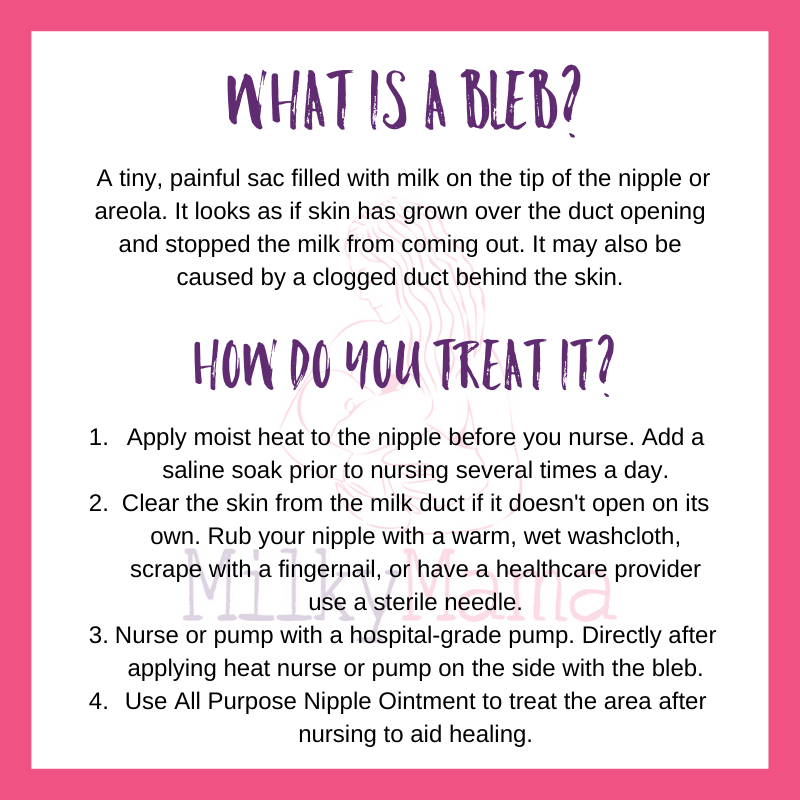What Is A Bleb?
Posted by Krystal Duhaney, RN, BSN, IBCLC on Jun 25th 2020
Right now some of you may be thinking, what in the world is a bleb? Well, today I’m going to break it down for you. This post will give you everything you need to know about blebs, including what to do if you get one.
What is a bleb?
If you haven’t heard of a bleb, you may have heard of a milk or nipple blister. They are a tiny, painful sac filled with milk on the tip of the nipple or areola. It will look as if skin has grown over the duct opening and stopped the milk from coming out. It may also be caused by a clogged duct behind the skin.
The tiny dot is typically white, clear or yellow in color and pain is located right at the tip or behind the duct. It can be painful to the touch and during feeds. Some blebs will pop-up for a few days while others are there for weeks.
What causes it?
There are multiple reasons why a bleb may appear. It can be caused by injury to the nipple or too much pressure on the breast. Clogged milk ducts or nipple pores, oversupply, or even milk that is too fatty or thick can also contribute to a milk blister, If you have issues with incorrect latch and positioning, or other problems such as a yeast infection, that can also be the cause.

How do you treat it?
Even though a bleb can be a cause for concern because of the tenderness, there are a few treatment options you can try at home. If you are unable to get the bleb to go away with any of these methods, see your healthcare provider so they can remove the bleb with a sterilized needle.
1. Apply moist heat to the nipple before you nurse.
Several times a day you should add an epsom salt soak prior to applying the moist heat. This will help keep the area clean while also helping to open up and heal the blockage.
You can easily do this by mixing 2 tablespoons of epsom salt with 1 cup of hot water. Either let the water cool on its own or add a small amount of cold water until it is cool enough to soak in. After you are done with the soak, apply the moist heat compress to the nipple to aid in softening the bleb. You can also use olive oil if you do not want to try moist heat. This should be done before nursing or pumping.
2. Clear the skin from the milk duct.
This may not be necessary if the epsom salt soak and moist heat have already opened up the skin or clogged duct.
To clear it you can try gently rubbing your nipple with a warm, moist washcloth. This movement may be enough to pull the skin back that is covering the opening. You may also use your fingernail to scrape back the skin. As I mentioned above, if none of this is working for you, have a healthcare professional use a sterile needle to open up the bleb.
3. Nurse or pump with a hospital-grade pump.
Directly after you apply the moist heat you should nurse first on the breast with the bleb. It can be helpful to massage the breast and hand express to assist in breaking up any of the thick, fatty milk that may be clogging the duct. This can aid in expressing the milk.
4. Use ointment to treat the bleb after nursing to aid healing.
All Purpose Nipple Ointment is antibacterial, anti-fungal, and anti-inflammatory. Using an ointment will ease the discomfort in between feedings. It will also help to speed up healing.
APNO should be applied after nursing and it is suggested to use a pea-sized amount. You do not need to wipe off before nursing again. Your healthcare provider can write you a prescription to be filled at your local pharmacy so if you think you are in need, call them right away.
Please be vigilant for signs of infection like fever, redness or inflammation, swelling, oozing or pus from the affected area. If you experience any of these symptoms contact your healthcare provider because you may need to take oral antibiotics if an infection is present.
Have you ever experienced a bleb? Did any of these treatments work for you? Let us know in The Official Milky Mama Lactation Support Group. This is your place to get advice from our team of Milky Mama experts and seasoned breastfeeding moms. If you are needing more one-on-one help book a call with one of our International Board Certified Lactation Consultants here.

